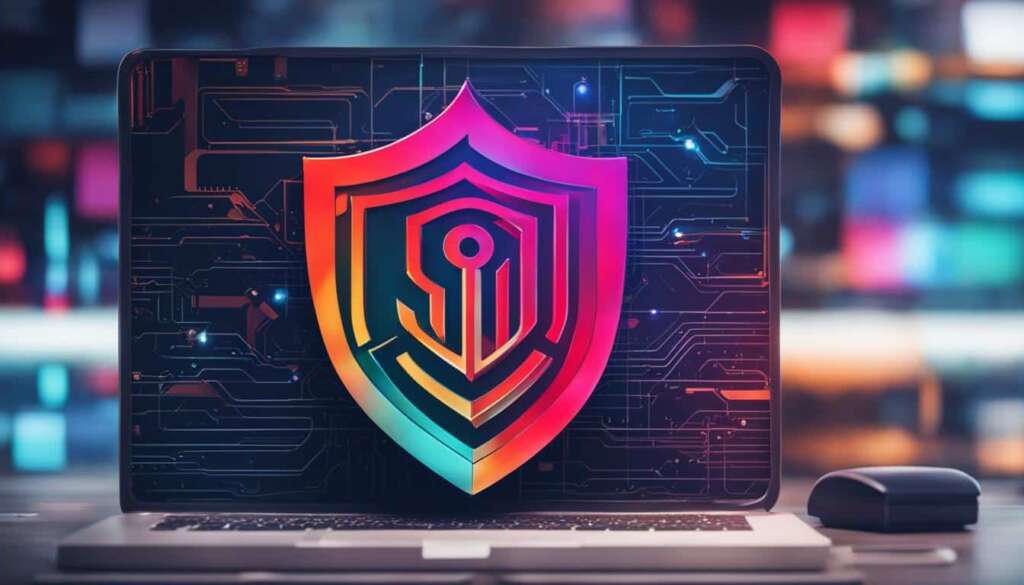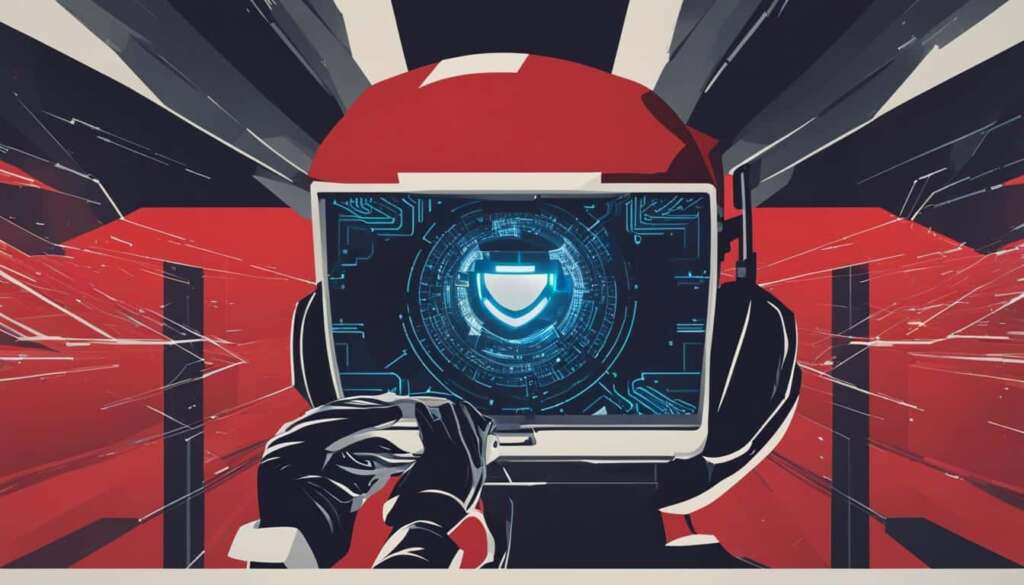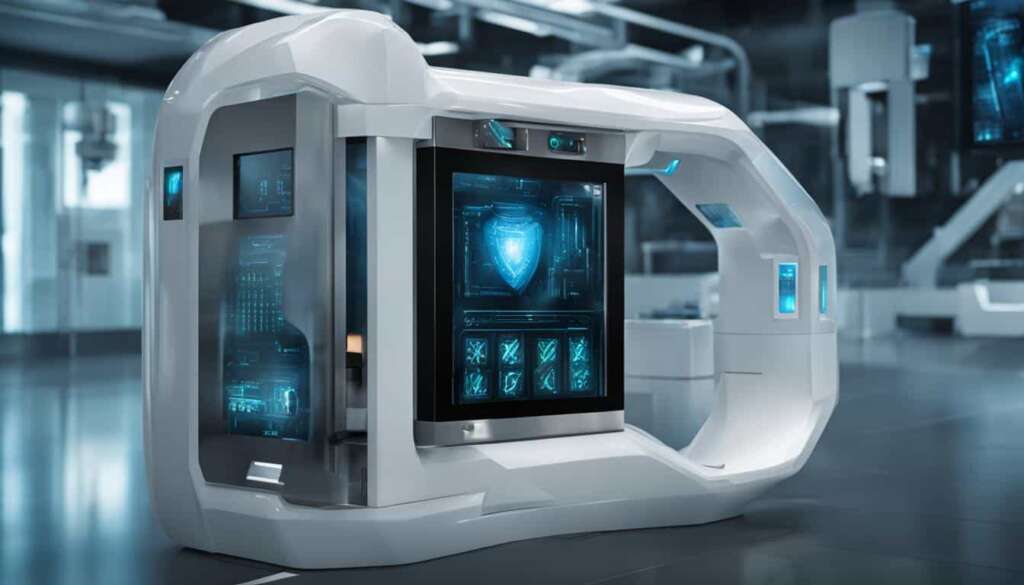Table of Contents
As technology continues to revolutionize the automotive industry, ensuring robust cybersecurity measures has become more crucial than ever. With the rise of connected vehicles, autonomous features, and software-enabled functionalities, the industry faces a new wave of cybersecurity risks. It is imperative for automotive companies to prioritize cybersecurity to protect vehicles and safeguard the safety of drivers and passengers.
From connected car security to the growing concerns of automotive hacking, the risks associated with inadequate cybersecurity practices are vast. Companies must implement comprehensive solutions and technologies to mitigate potential threats and vulnerabilities. By adopting best practices and continuously monitoring for risks, the automotive industry can enhance its cybersecurity posture and ensure the safe and secure operation of vehicles.
Importance of Vehicle Cybersecurity
The rapid advancement of technology in the automotive industry has brought about numerous benefits, such as connected vehicles and autonomous features. However, with these advancements also come new and evolving cybersecurity threats. It is vital for the automotive industry to prioritize vehicle cybersecurity to ensure the safety of drivers, passengers, and the integrity of the vehicles themselves.
Vehicle cybersecurity plays a critical role in protecting against potential attacks and unauthorized access. It safeguards the proper functioning of safety-critical systems, preventing any compromise that could lead to accidents or dangerous situations. By adhering to automotive cybersecurity best practices, manufacturers, and individuals can mitigate the risks associated with cyber threats and ensure the continued safety of vehicles on the roads.
Implementing robust cybersecurity measures is key to maintaining the integrity of safety features in vehicles. From secure software development practices to regular security audits and updates, automotive cybersecurity best practices should be followed at every stage of the vehicle’s lifecycle. This includes secure coding, encryption, authentication protocols, and continuous monitoring to detect and respond to potential vulnerabilities.
Table: Key Best Practices for Vehicle Cybersecurity
| Best Practices | Description |
|---|---|
| Secure Software Development | Implement a secure coding methodology and conduct rigorous testing to detect and fix vulnerabilities in vehicle software. |
| Regular Security Audits | Conduct periodic security audits to identify potential vulnerabilities and address them promptly. |
| Encryption | Ensure that sensitive data transmitted between vehicle components and external systems is encrypted to prevent unauthorized access. |
| Authentication Protocols | Implement robust authentication protocols to prevent unauthorized access to vehicle systems. |
| Continuous Monitoring | Establish a system for monitoring and detecting potential cybersecurity threats, allowing for timely response and mitigation. |
Ensuring vehicle cybersecurity is a collaborative effort that involves manufacturers, suppliers, regulators, and consumers. By working together and adopting best practices, the automotive industry can effectively address the risks associated with cyber threats and create a safer environment for everyone on the road.
Vehicle Cybersecurity Challenges
The automotive industry faces numerous challenges when it comes to cybersecurity. As vehicles become more connected and technologically advanced, the risks of cyber threats and attacks increase. These challenges require a comprehensive and layered approach to cybersecurity, involving collaboration among all stakeholders and continuous monitoring of potential vulnerabilities.
Remote Threats
One of the key challenges in vehicle cybersecurity is the rise of remote threats. Hackers can target vehicles’ wireless communication systems, enabling them to gain unauthorized access and potentially control critical functions of the vehicle. This not only poses a risk to the safety of drivers and passengers but also opens up possibilities for theft and malicious activities.
Keyless Car Theft
Keyless car theft has become a significant concern in the automotive industry. Hackers can exploit vulnerabilities in keyless entry systems to intercept the communication between the car and the key fob, allowing them to gain unauthorized access to the vehicle. This type of theft can be carried out without triggering alarms, making it difficult to detect and prevent.
Exploitation of EV Charging Stations
The rise of electric vehicles (EVs) brings new challenges in terms of cybersecurity. Threat actors can target EV charging stations to execute malware attacks, commit fraud, or manipulate the charging process. This not only affects the charging infrastructure but also poses risks to the safety and integrity of the vehicles themselves.
| Vehicle Cybersecurity Challenges | Examples |
|---|---|
| Remote Threats | Unauthorized access, control of critical functions |
| Keyless Car Theft | Intercepting communication between car and key fob |
| Exploitation of EV Charging Stations | Malware attacks, fraud, manipulation of charging process |
In order to address these challenges, the automotive industry needs to prioritize cybersecurity and implement robust measures to protect vehicles and drivers from potential threats. This includes regular software updates, strong encryption protocols, network segmentation, and continuous monitoring of the connected car ecosystem.
Furthermore, collaboration among manufacturers, suppliers, and cybersecurity experts is crucial to share knowledge, best practices, and threat intelligence. By working together, the industry can develop robust solutions and technologies to mitigate the risks associated with vehicle cybersecurity challenges and ensure the safety and security of connected cars.
Keyless Car Theft
Keyless car theft is a significant cybersecurity risk in the automotive industry. Hackers have found ways to exploit keyless entry systems, allowing them to gain unauthorized access to vehicles without triggering any alarms or leaving visible signs of a break-in. This type of theft is particularly concerning as it has become increasingly prevalent in recent years, affecting both individual car owners and fleet operators.
One of the key vulnerabilities exploited by hackers is the interception of data transmitted between the car and the key fob. By using specialized equipment, cybercriminals can capture and replicate the signals, tricking the vehicle into unlocking and starting without the legitimate key nearby. This method, known as relay attacks, has become a favored technique among car thieves, as it requires minimal effort and can be executed quickly and discreetly.
“Keyless entry systems are a convenient feature in modern vehicles, but they come with inherent security risks. Vehicle owners should be aware of the threat of keyless car theft and take necessary precautions to protect their vehicles.”
To mitigate the risk of keyless car theft, manufacturers and car owners can employ various countermeasures. For example, the implementation of secure communications protocols and encryption standards can make it more difficult for hackers to intercept and manipulate the signals. Additionally, vehicle owners can use steering wheel locks, signal-blocking pouches, or Faraday boxes to prevent unauthorized access to their key fobs.
| Countermeasures | Description |
|---|---|
| Secure communications protocols and encryption | Implementing robust encryption algorithms and secure communication protocols can make it harder for hackers to intercept and manipulate keyless entry signals. |
| Steering wheel locks | Physical deterrents like steering wheel locks can provide an additional layer of protection, making it more challenging for thieves to drive away with a vehicle. |
| Signal-blocking pouches | Signal-blocking pouches or wallets can prevent the transmission of keyless entry signals, effectively shielding the key fob from remote interception. |
| Faraday boxes | Faraday boxes create an electromagnetic shield around the key fob, blocking any incoming or outgoing signals, thereby preventing relay attacks. |
Awareness and vigilance are crucial in combating keyless car theft. Vehicle owners should stay informed about the latest security vulnerabilities and recommended countermeasures. By taking proactive steps to protect their vehicles, they can significantly reduce the risk of falling victim to this type of cybersecurity threat.

Additional Tips to Protect Against Keyless Car Theft:
- Store key fobs in a secure location, away from doors and windows to minimize the risk of signal interception.
- Consider disabling keyless entry features if they are not regularly used.
- Check with the vehicle manufacturer for any software updates or security enhancements related to keyless entry systems.
- Install aftermarket security devices such as tracking systems or immobilizers to deter thieves.
EV Charging Station Exploitation
In the era of electric vehicles, the proliferation of EV charging stations has greatly facilitated the adoption of sustainable transportation. However, this rapid expansion comes with a new set of cybersecurity risks that must be addressed. EV charging station exploitation has emerged as a significant concern, as threat actors aim to exploit vulnerabilities in these systems for their malicious intent.
Attackers may target EV charging stations to execute malware attacks, commit fraud, manipulate charging processes, or disable the stations altogether. These actions not only compromise the availability and reliability of charging infrastructure but also jeopardize the safety and trust of electric vehicle owners. Thus, securing EV charging stations has become a critical component of overall automotive cybersecurity efforts.
To mitigate the risks associated with EV charging station exploitation, various measures must be implemented. Firstly, robust authentication and authorization mechanisms must be in place to ensure that only authorized users have access to the charging infrastructure. This can include secure logins with strong passwords, two-factor authentication, or even biometric authentication.
Furthermore, continuous monitoring and timely patching of software and firmware vulnerabilities are essential to prevent unauthorized access and potential attacks. Regular security assessments and audits can identify existing weaknesses, allowing for prompt remediation and proactive strengthening of the charging station’s security posture.
In conclusion, the rise of electric vehicles and the widespread deployment of EV charging stations present new challenges in automotive cybersecurity. Addressing the risks associated with EV charging station exploitation is crucial to protect the integrity of charging infrastructure, ensure the safety of electric vehicle owners, and promote the long-term sustainability of the automotive industry.
Table: EV Charging Station Exploitation Vulnerabilities and Mitigation Strategies
| Vulnerabilities | Mitigation Strategies |
|---|---|
| Malware attacks | Regular software and firmware updates, antivirus protection |
| Fraud | Secure authentication, encryption of sensitive data |
| Manipulation of charging processes | Security measures like secure protocols, integrity checks |
| Disabling charging stations | Physical security measures, intrusion detection systems |
Infotainment System Attacks
The increasing integration of technology in vehicles has brought about numerous benefits, but it has also exposed the automotive industry to new cybersecurity risks. One of the areas vulnerable to attacks is the infotainment system, which serves as a gateway to the vehicle’s electronic control unit (ECU). Hackers can exploit vulnerabilities in these systems to gain unauthorized access and potentially compromise the safety and control of the vehicle.
Infotainment system attacks pose significant risks to connected car security. By gaining access to the ECU, hackers can manipulate critical functions like braking, acceleration, and steering, posing a direct threat to the lives of drivers and passengers. Manufacturers must prioritize the security of these systems by conducting regular vulnerability assessments and implementing robust security measures.
“The integration of infotainment systems in modern vehicles has revolutionized the driving experience, but it has also introduced new attack vectors for cybercriminals,” says cybersecurity expert Dr. Emily Collins.
“It is essential for manufacturers to address vulnerabilities promptly and keep their firmware updated to stay ahead of potential threats.”

In conclusion, protecting infotainment systems from cyberattacks is crucial for maintaining the safety and security of connected vehicles. By implementing robust security measures, conducting regular vulnerability assessments, and keeping firmware up to date, the automotive industry can mitigate the risks associated with infotainment system attacks and ensure the continued trust of drivers and passengers.
Brute Force Network Attacks in the Automotive Industry
The automotive industry is not immune to cyber threats, and one of the significant risks it faces is brute force network attacks. These attacks involve repeated attempts to gain unauthorized access to a network by systematically trying all possible combinations of passwords or encryption keys. In the context of the automotive industry, brute force network attacks pose a severe threat to connected car security, potentially compromising vehicle functionality and putting drivers and passengers at risk.
Brute force network attacks exploit weak or easily guessable passwords and vulnerabilities in network security protocols. With the increasing connectivity of vehicles, networks are becoming more susceptible to attacks if not adequately protected. It is crucial for automotive stakeholders, including manufacturers, suppliers, and service providers, to implement strong credential management practices and robust network security measures to mitigate the risks posed by brute force attacks.
“Brute force network attacks exploit weak or easily guessable passwords and vulnerabilities in network security protocols.”
The Impact of Brute Force Network Attacks
Brute force network attacks can have severe consequences for the automotive industry. If attackers gain unauthorized access to vehicle networks, they can potentially manipulate critical systems and compromise the safety features of vehicles. This puts drivers and passengers at risk of accidents or other safety incidents. Additionally, successful brute force attacks can result in the theft of sensitive data, lead to financial losses, and damage the reputation of automotive companies.
To prevent and mitigate the impact of brute force network attacks, automotive stakeholders should adopt a multi-layered approach to cybersecurity. This includes regularly updating and patching network systems, implementing strong password policies, conducting security assessments, and monitoring network traffic for suspicious activities. By prioritizing connected car security and taking proactive measures, the automotive industry can defend against brute force network attacks and ensure the safety and integrity of connected vehicles.

Table: Comparison of Key Measures to Mitigate Brute Force Network Attacks
| Measure | Description | Impact |
|---|---|---|
| Password Complexity | Enforcing strong, complex passwords for network access | Reduces the likelihood of successful brute force attacks |
| Account Lockout Policies | Automatically locking user accounts after a specified number of unsuccessful login attempts | Limits the effectiveness of brute force attacks by preventing further attempts |
| Two-Factor Authentication | Requiring an additional authentication factor, such as a unique code sent to a user’s mobile device, in addition to a password | Provides an extra layer of security, making it more difficult for attackers to gain unauthorized access |
| Network Monitoring | Continuous monitoring of network traffic for anomalous activity and potential brute force attempts | Enables prompt detection and response to potential threats, reducing the impact of successful attacks |
Phishing Attacks and Automotive Cybersecurity Risks
When it comes to automotive cybersecurity, one of the major risks that organizations and individuals need to be aware of is phishing attacks. Phishing attacks are a common method used by hackers to gain unauthorized access to automotive networks and exploit vulnerabilities. By posing as trusted entities, cybercriminals can trick employees into disclosing sensitive information or executing malicious code, allowing them to penetrate the target network and perform further attacks from within. The consequences of a successful phishing attack can be severe, ranging from data breaches to financial losses and compromised vehicle safety.
Protecting against phishing attacks requires a multifaceted approach. One of the key strategies is implementing robust training programs and awareness campaigns to educate employees and stakeholders about the risks associated with phishing. By promoting a culture of cybersecurity awareness, organizations can empower their workforce to identify and report suspicious emails, links, or requests. Additionally, implementing strong email filters and authentication protocols can help detect and block phishing attempts before they reach the intended targets.
Furthermore, organizations should regularly update their security systems and software to address known vulnerabilities that could be exploited by phishing attacks. Conducting regular security assessments and penetration testing can also help identify and mitigate potential weaknesses in the network infrastructure. By staying proactive and vigilant, organizations can enhance their resilience against phishing attacks and strengthen their overall automotive cybersecurity posture.
| Vulnerability | Risk | Countermeasure |
|---|---|---|
| Inadequate employee training | Risk of falling victim to phishing attacks | Implement comprehensive training and awareness programs to educate employees about phishing risks and mitigation strategies. |
| Weak email filters | Increased likelihood of successful phishing attempts | Implement strong email filters and authentication protocols to detect and block phishing emails. |
| Outdated software and security systems | Exposure to known vulnerabilities | Regularly update software and security systems to address known vulnerabilities that could be exploited by phishing attacks. |
| Lack of security assessments and penetration testing | Unidentified weaknesses in network infrastructure | Conduct regular security assessments and penetration testing to identify and mitigate potential weaknesses in the network infrastructure. |
Best Practices for Phishing Attack Prevention:
- Provide regular training and awareness programs to educate employees about phishing risks and mitigation strategies.
- Implement strong email filters and authentication protocols to detect and block phishing emails.
- Regularly update software and security systems to address known vulnerabilities that could be exploited by phishing attacks.
- Conduct regular security assessments and penetration testing to identify and mitigate potential weaknesses in the network infrastructure.
- Encourage employees to report suspicious emails, links, or requests to the appropriate IT security team.
By implementing these best practices and maintaining a proactive approach towards phishing attack prevention, the automotive industry can enhance its cybersecurity posture and protect against the risks posed by phishing attacks. A comprehensive strategy that encompasses employee training, robust technical measures, and regular assessment will help mitigate the potential impact of phishing attacks and ensure the safety and security of connected cars.

Compromised Aftermarket Devices
One of the significant cybersecurity risks in the automotive industry is the use of compromised aftermarket devices. These third-party connected devices, such as insurance dongles and smartphones, can pose serious threats to the security of vehicles and connected car systems. Cybercriminals may exploit the vulnerabilities in these devices to introduce malware and backdoors into vehicle systems, potentially compromising the safety and integrity of the vehicle’s operation.
To mitigate these risks, it is crucial for all stakeholders, including consumers and dealerships, to exercise caution and implement best practices when using and trading vehicles with aftermarket devices. This includes verifying the legitimacy of the device manufacturer, ensuring regular firmware updates, and maintaining strong security measures. Raising awareness about the potential risks associated with compromised aftermarket devices is also essential in protecting the automotive ecosystem from cyber threats.
Table: Examples of Compromised Aftermarket Devices and Potential Risks
| Device | Potential Risks |
|---|---|
| Insurance dongles | Introduction of malware into vehicle systems, unauthorized access |
| Smartphones | Backdoor access to vehicle networks, data leakage |
| Aftermarket entertainment systems | Compromised infotainment systems, potential control over safety-critical functions |
By recognizing the risks posed by compromised aftermarket devices and proactively addressing them, the automotive industry can take significant steps towards ensuring connected car security and safeguarding the vehicles and systems from potential cyber threats.
Ransomware
Ransomware attacks pose a significant threat to the automotive industry, highlighting the urgency for robust cybersecurity measures. These attacks involve the encryption of critical data, rendering it inaccessible until a ransom is paid. Without adequate protection, automotive organizations, including OEMs, dealers, and consumers, risk financial losses and operational disruptions.
Connected car security plays a crucial role in mitigating the impact of ransomware attacks. Implementing a multi-layered defense strategy is essential, starting with robust network security measures to prevent unauthorized access. Regular patch management and software updates also help address known vulnerabilities and enhance the overall security posture.
Furthermore, organizations should have an incident response plan in place to quickly detect and respond to ransomware attacks. This includes regular data backups, offline storage, and secure restoration processes. By prioritizing cybersecurity and implementing preventive and reactive measures, the automotive industry can effectively defend against ransomware attacks and safeguard critical systems and data.
| Ransomware Mitigation Strategies | Description |
|---|---|
| Network Segmentation | Divide the network into isolated segments to contain the spread of ransomware and limit unauthorized access. |
| Patch Management | Maintain up-to-date software and firmware by regularly applying patches and security updates. |
| Backup and Recovery | Regularly backup critical data and ensure offline storage to restore systems in the event of a ransomware attack. |
| User Education | Train employees and users to identify and avoid potential ransomware threats, such as suspicious emails or downloads. |
| Access Controls | Implement strong access controls and authentication mechanisms to prevent unauthorized access to sensitive systems and data. |
Automotive Supply Chain Attacks
As the automotive industry becomes increasingly interconnected, the risk of cyberattacks grows exponentially. One area of concern is automotive supply chain attacks. This type of attack involves compromising the production or distribution processes of automotive components, allowing hackers to introduce malicious code or gain unauthorized access to vehicles. The consequences of a successful supply chain attack can be devastating, posing threats to consumer safety and the reputation of manufacturers.
Supply chain attacks can occur at various stages of the production and distribution process. For example, hackers may target suppliers or subcontractors, leveraging their vulnerabilities to gain access to sensitive data or compromise the integrity of components. These compromised components can then be installed in vehicles, potentially granting hackers unauthorized access and control over critical systems.
To mitigate the risk of automotive supply chain attacks, manufacturers and suppliers need to implement robust cybersecurity measures throughout the entire supply chain. This includes conducting thorough security audits of suppliers, ensuring secure communication channels, and implementing strong access controls. Furthermore, manufacturers need to establish strict quality control processes to detect tampering or malicious code in components before they are installed in vehicles.
Table: Examples of Automotive Supply Chain Attacks
| Attack Type | Description |
|---|---|
| Malware Injection | Hackers inject malicious code into a component during the manufacturing process, compromising the integrity of the entire vehicle. |
| Unauthorized Access | Hackers gain unauthorized access to a supplier’s systems and manipulate production or distribution processes to introduce vulnerabilities into components. |
| Data Breach | Hackers breach a supplier’s database, compromising sensitive information related to vehicle designs, manufacturing processes, or customer data. |
Addressing the risk of automotive supply chain attacks requires collaboration and shared responsibility among all stakeholders in the industry. Manufacturers, suppliers, and regulatory bodies must work together to establish stringent cybersecurity standards and protocols. Regular audits and vulnerability assessments should be conducted to identify and address potential vulnerabilities in the supply chain. Additionally, continuous monitoring and threat intelligence sharing can help detect and respond to supply chain attacks in a timely manner.
By implementing these proactive measures, the automotive industry can strengthen its defenses against supply chain attacks and ensure the safety and security of vehicles on the road. As the industry continues to embrace connectivity and innovation, cybersecurity must remain a top priority to protect both the integrity of the supply chain and the trust of consumers.
Conclusion
Ensuring automotive cybersecurity is crucial for protecting vehicles, drivers, and passengers. The industry must adopt a multi-faceted approach that emphasizes collaboration, best practices, continuous monitoring, and timely response to potential threats. By prioritising cybersecurity and implementing robust solutions and technologies, the automotive industry can mitigate risks and ensure the safe and secure operation of vehicles.
The importance of automotive cybersecurity cannot be overstated. With the rapid integration of technology in vehicles, there is a pressing need to safeguard against potential attacks and safety compromises. Adhering to best practices is essential for protecting safety-critical systems and mitigating the risks associated with cyber threats.
The automotive industry faces various cybersecurity challenges, including keyless car theft, EV charging station exploitation, attacks on infotainment systems, brute force network attacks, phishing attacks, compromised aftermarket devices, ransomware threats, and automotive supply chain attacks. Addressing these challenges requires a comprehensive and layered approach to cybersecurity, involving collaboration among all stakeholders and continuous monitoring of potential vulnerabilities.
As the automotive industry continues to evolve, so do the cybersecurity risks. It is essential for manufacturers, consumers, and other industry stakeholders to stay vigilant and proactive in protecting vehicles and ensuring the safety of everyone on the road. By embracing automotive cybersecurity solutions and technologies, the industry can stay ahead of cyber threats and maintain the trust and confidence of drivers and passengers.
FAQ
What is the importance of vehicle cybersecurity?
Vehicle cybersecurity is crucial for protecting against potential attacks, unauthorized access, and safety compromises. It ensures the proper functioning of safety-critical systems and mitigates the risks associated with cyber threats.
What are the challenges faced in vehicle cybersecurity?
The automotive industry faces various cybersecurity challenges, including remote threats, keyless car theft, exploitation of EV charging stations, attacks on infotainment systems, brute force network attacks, phishing attacks, compromised aftermarket devices, ransomware threats, and automotive supply chain attacks.
How does keyless car theft pose a cybersecurity threat?
Keyless car theft allows hackers to intercept data connections between the car and the key fob, enabling them to gain unauthorized access and start the vehicle without triggering alarms. Manufacturers and consumers need to be aware of the risks associated with keyless car theft and take appropriate measures to protect their vehicles.
How can EV charging stations be exploited for cyberattacks?
Threat actors can target EV charging stations to execute malware attacks, commit fraud, manipulate charging processes, or disable charging stations. Securing EV charging infrastructure is crucial to ensure the safe and efficient operation of electric vehicles.
How can infotainment system attacks compromise vehicle safety?
Hackers can exploit vulnerabilities in infotainment systems to gain unauthorized access to the vehicle’s electronic control unit (ECU) and potentially endanger the lives of drivers and passengers. Manufacturers need to prioritize the security of infotainment systems and regularly update firmware to address known vulnerabilities.
What are the risks associated with brute force network attacks?
Brute force network attacks target network credentials to gain unauthorized access to systems and potentially compromise firmware, leak sensitive data, or facilitate vehicle theft. Implementing strong credential management practices, network segmentation, and regular security assessments are essential to mitigate the risks associated with brute force attacks.
How can organizations defend against phishing attacks in the automotive industry?
Robust training programs and awareness campaigns can help organizations defend against phishing attacks. By posing as trusted entities, cybercriminals can trick employees into disclosing sensitive information or executing malicious code, allowing them to penetrate the target network and perform further attacks from within.
What are the risks associated with compromised aftermarket devices?
Third-party connected devices, such as insurance dongles and smartphones, can introduce malware and backdoors into vehicle systems, potentially compromising the security of subsequent owners. It is crucial for all stakeholders, including consumers and dealerships, to be cautious when using and trading vehicles with aftermarket devices.
How can the automotive industry mitigate the impact of ransomware attacks?
Implementing robust cybersecurity measures, such as patch management, network segmentation, and incident response plans, is essential to mitigate the impact of ransomware attacks. Ransomware involves holding organizations’ data hostage in exchange for a ransom, potentially causing financial and operational disruptions.
What risks are associated with automotive supply chain attacks?
The complex supply chain of the automotive industry presents a significant cybersecurity risk, as every connected endpoint becomes a potential vulnerability. Malicious actors can compromise firmware, push updates with malicious code, or disrupt supplier operations, causing severe consequences for the industry and potentially impacting consumer safety.
Why is prioritizing cybersecurity in the automotive industry important?
Ensuring cybersecurity in the automotive industry is crucial for protecting vehicles, drivers, and passengers. By prioritizing cybersecurity and implementing robust solutions and technologies, the automotive industry can mitigate risks and ensure the safe and secure operation of vehicles.
Source Links
- https://www.nhtsa.gov/technology-innovation/vehicle-cybersecurity
- https://www.csoonline.com/article/652299/automotive-supply-chain-vulnerable-to-attack-as-cybersecurity-regulation-looms.html
- https://cybersecurity.att.com/blogs/security-essentials/the-top-8-cybersecurity-threats-facing-the-automotive-industry-heading-into-2023













